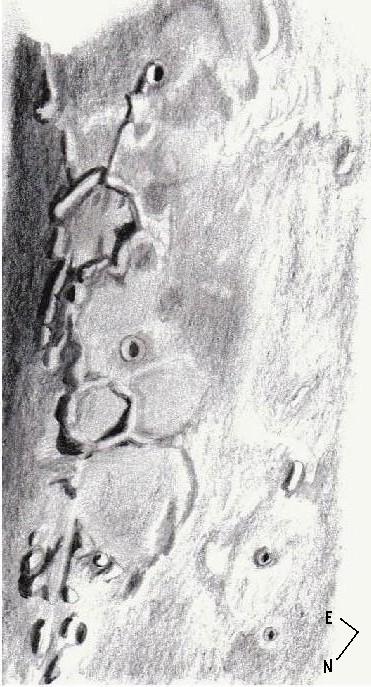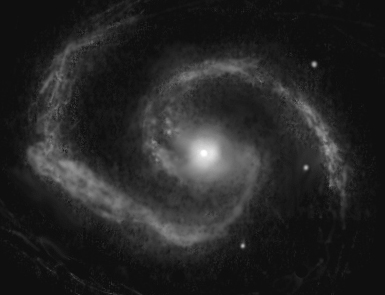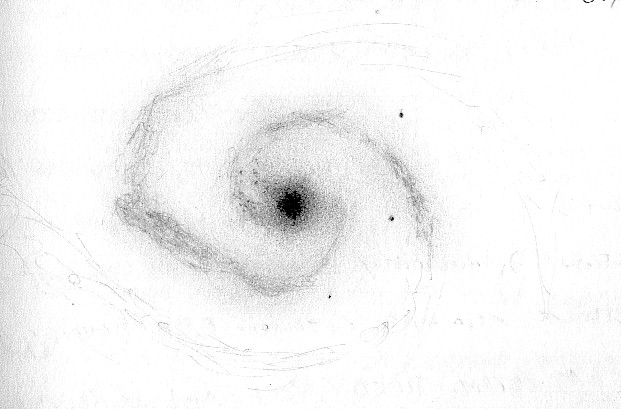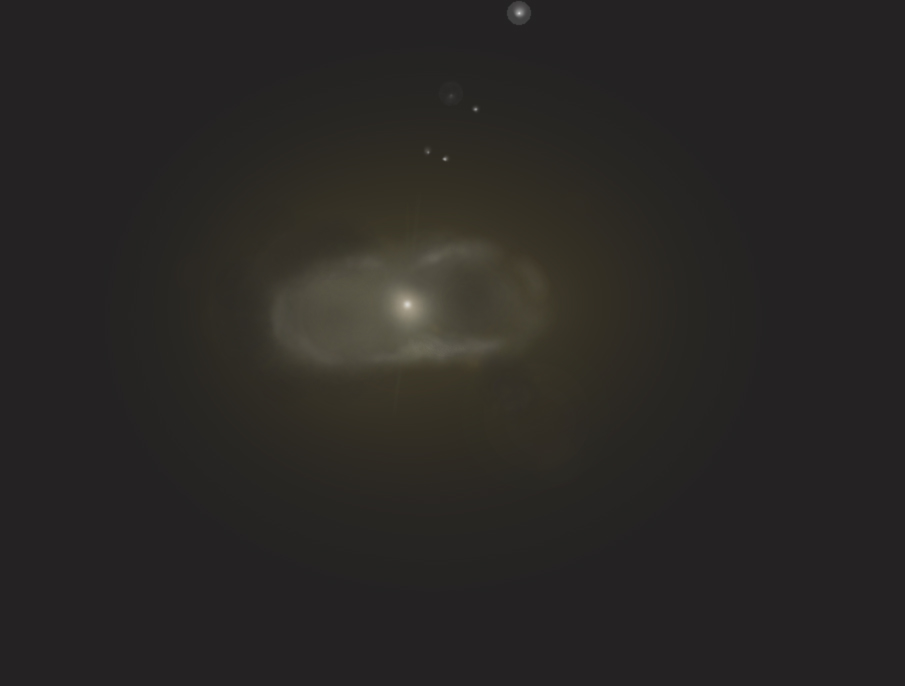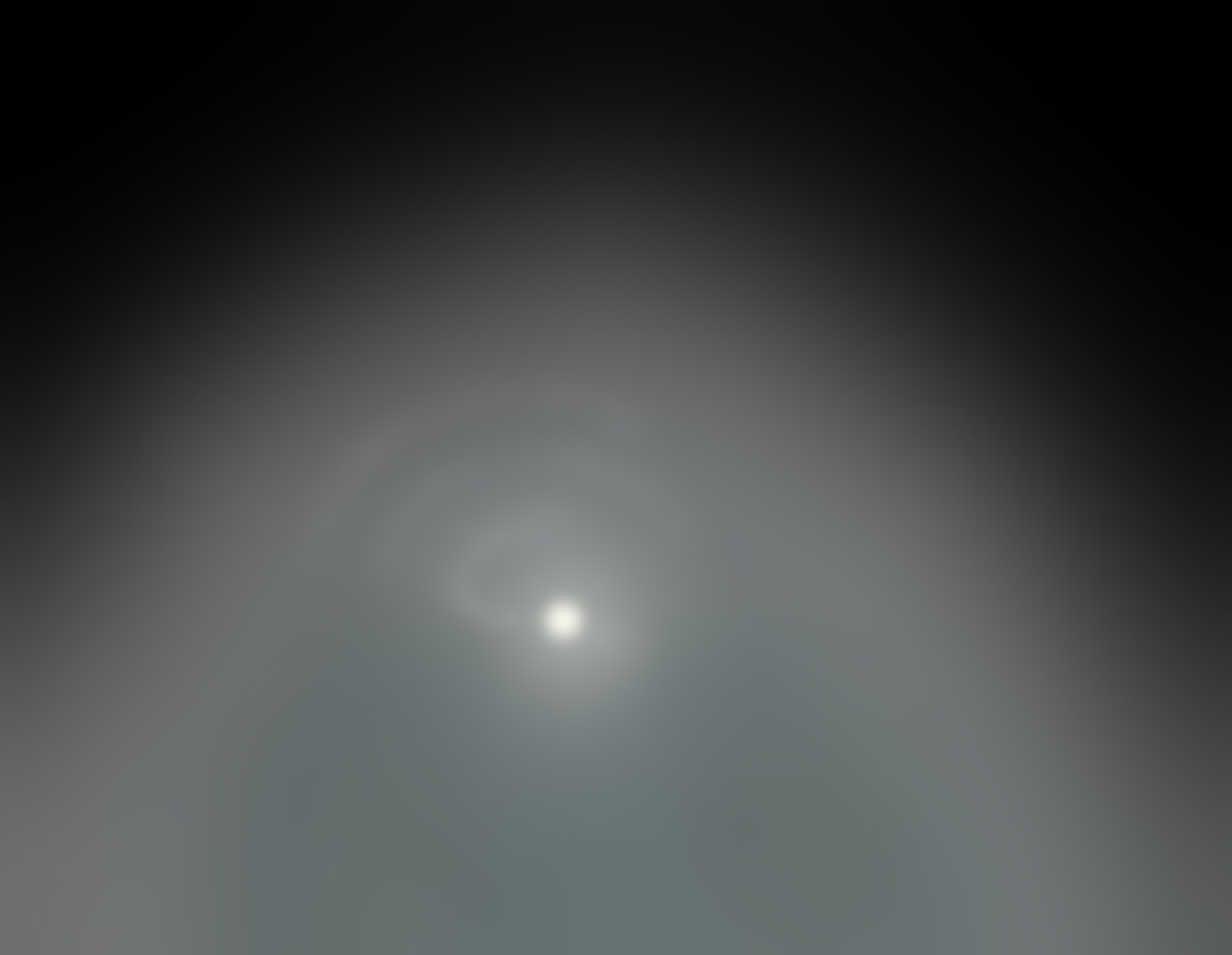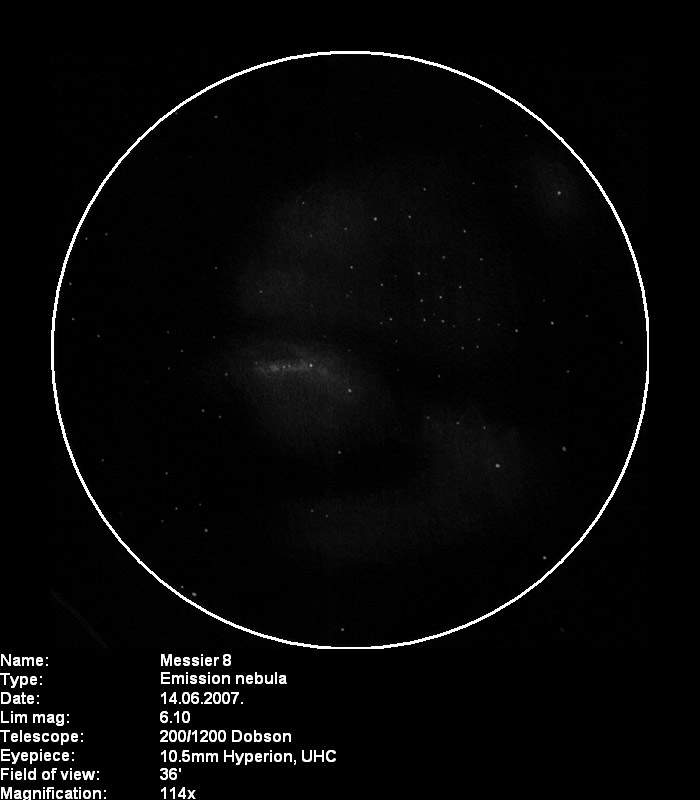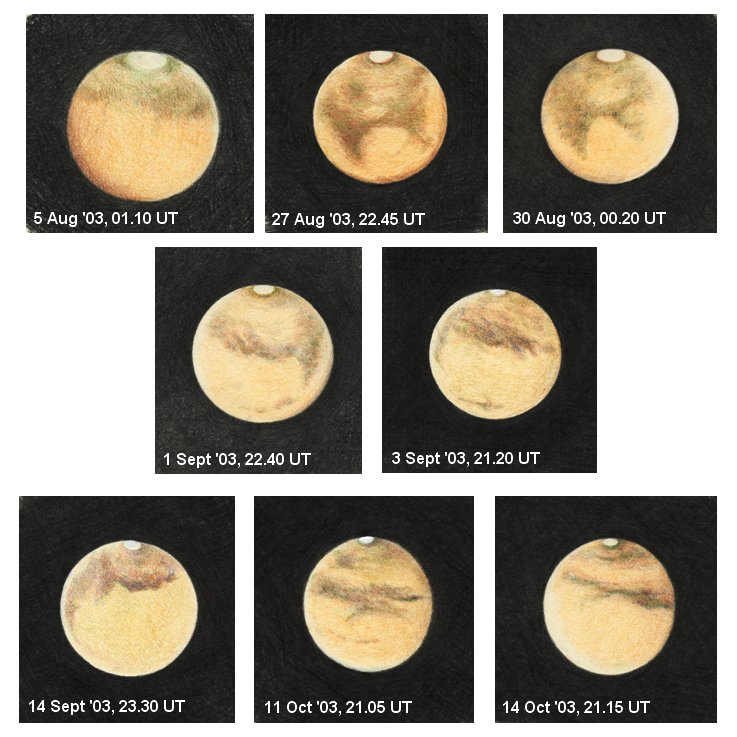On a frosty early morning in the fall of 2006, just a couple of days past third
quarter moon, I selected for sketching a famous old battered region between Mare
Nubium and Mare Cognitum. This region includes four large craters that were
damaged by low flying Imbrium ejecta that caused them to look old and battered
before their time. Nearest the terminator to the north is crater Guericke (59km)
with its flat lava flooded floor that opens to Mare Nubium. Crater Parry, smaller
at 49 km in diameter is older and also flat floored. The other two craters which
look ghostly in the sketch are larger and older and share common walls with Parry.
These craters are Bonpland (61 km.) to the west and Fra Mauro (96 km.) to the
north of Parry. The wall of Parry encroaches on Bonpland and both together on to
Fra Mauro to betray the cratering sequence of these three.
Sketching:
For this sketch I used: copy paper 8.5”x11”, #2HB graphite pencil,
Pink pearl eraser.
Telescope: 6 inch f/ 7.9 Dobsonian at 208x ( first light for this scope)
Date: 10-15-2006 10:30-11:15 UT
Temperature: 0° C (32° F)
Clear, calm
Seeing: Antoniadi III
Co longitude: 190 °
Lunation: 23 days
Illumination: 36 %
Frank McCabe
Category: Pencil
Joys of Jupiter

This was the first sketch for me in a long while. It is a medium that I had moved
away from as I moved more into astrophotography. This site compeled me to give it
another go. You can see how the Jovian bands have become more mixed in the recent
months. This was also shown on a recent release of photos from Hubble. My sketch was
done with pencil on a sketch pad and reflect what I saw through a 12″ DOB using a
Televue Nagler type 6 7mm ep. It was really fun to experience this medium again. I
will certainly not wait so long for the next sketch. I hope that you enjoy it as
much as I enjoyed doing it.
Hulett Keaton
Eagle Mountain Station
Carpe noctem
Clarity brought to complexity
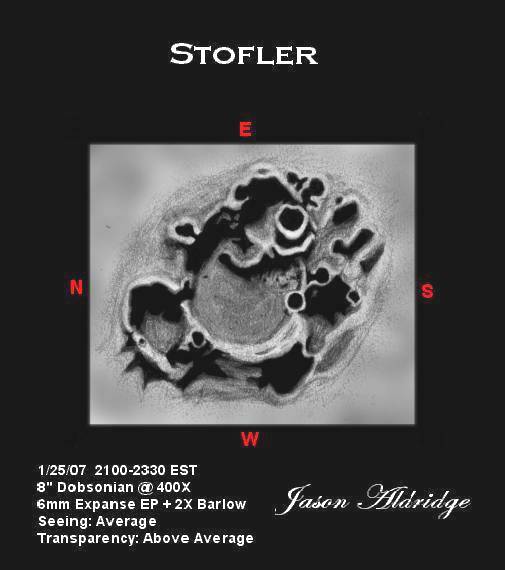
This is my impression of the Lunar Formation Stofler. It was sketched with a #2HB
0.5mm mechanical pencil on Strathmore Wind Power Sketching Paper. Other pertinent
details are on the sketch itself. I found this lunar feature to be one of the most
interesting that I have seen. It appeared to me, that this piece of lunar real
estate was painted with a giant bulls eye.
Jason Aldridge
Repsold on the rim
A favourable lunar libration put the crater Repsold at a better
perspective than what one usually finds. And finding it on the
terminator made it an object for a quick sketch despite the obstacles.
It was only a few days before a June full moon so the moon was quite low
(from 50 degrees north lat.) even when near the meridian. Turbulence
and generally poor seeing kept things from looking sharp for more than
brief instants. And the mosquitoes were bad enough that at times they
cast long shadows across my sketching paper. Sketch done using
graphite pencils, ink and some not entirely successfull applications of
whiteout. I usually like to take longer with a sketch but the
mosquitoes kept the viewing short. North is more or less up and east is
to the left. Viewed through 150mm f/6 Maksutov Newtonian with
binoviewer, 2x barlow and 23mm eyepieces.
Repsold is a rather large crater at approximately 110 kms diameter that
is known for a prominant rille of the same name that runs through it.
Some of the unusual highpoints in the sunlight of my sketch might be
part of that formation as they are oriented in an agreeable direction.
But being unfamiliar with that extreme limb crater, I cannot say for
certain. Sketching limb craters present its own unique challenges and I
find myself thinking more of the three-dimensionality of the crater as
you are no just ‘looking down’ onto the third dimension.
Gerry Smerchanski
Heart of the vortex
May 29, 2006
Raw pencil sketch (HB lead), negative view lightly processed with
Photoshop Elements
Raw sketch was drawn at the eyepiece
28 inch f4 Newtonian at 710x
Seeing 8/10
Transparency 8/10
Limiting magnitude 6.4
Once upon a time, or last May 29th to be exact, I was lucky enough to
experience one of those amazing nights that we all hope for every time
the sky clears. The sky was dark, transparent and steady and the
temperature was surprisingly comfortable. In short, just about perfect.
But the best part was seeing something new and surprising in an object
I’ve looked at many, many times through all sizes of telescopes.
M51 was near the zenith and looked great at first glance, which wasn’t
unexpected since I was looking at it through a 28″ Newtonian after all –
it should look great! But it looked even better than normal because of
the excellent sky conditions which to me means piling on the
magnification. One of the features I enjoy trying to see within M51 is
the beginning of one of the main spiral arms coming out of the core.
They look like two faint prongs projecting out from the northern side of
the core and quickly blend into that spiral arm. These prongs are
visible in almost every M51 photo which inspired me to try to see them
visually in the first place. I’ve seen them well in a 16 inch scope and
suspect a 12 inch would be able to pull them in too.
At 710x I started seeing small glimmerings of light shimmer in and out
of view within the prongs, like they were studded with tiny, barely seen
stars. But at 31 million light years distant M51 I must have been seeing
something else. Looking at the latest HST image of M51 these objects are
probably HII star forming regions and huge star clusters and probably a
Milky Way foreground star or two.
A brief aside on my sketch – I concentrated on the core area and the
star-like points that glimmered in and out of view and that the farther
from the core I got the less detail I put in the sketch. Also, the fine
textures around the core and prongs are probably an artifact originally
caused by the texture of my notebook paper. The original pencil sketch
was scanned and enlarged about 300%, and then lightly processed in
Photoshop.
Howard Banich
Portland, Oregon
Little Man Big
The Homunculus Nebula is one of my personal favorites when it comes to southern
hemisphere deep sky objects. I was favored with good seeing conditions one evening
and attempted a sketch using a soft lead pencil.
The Homunculus (Latin for “little man”) surrounds the notoriously variable star Eta
Carinae. Using a 4mm Plossl with a twelve inch f/10 Schmidt-Cassegrain (~760X), this
peculiar reflection nebula resembled a pale yellow bipolar planetary nebula. At
times, I thought the bipolar lobes appeared as a weak reddish color but I could
never hold the sight long enough to be certain. The disc was quite irregular in
shape and displayed much subtle detail. Eta Carinae was also of a subtle yellowish
tint. Indeed, Eta is included in the list of “red” stars compiled by George Chambers
back in the late 19th century.
The ASOD drawing was copied from the original sketch using Photoshop. The airbrush,
blurring and dodging tools were used.
Dave Riddle
Smyrna, Georgia USA
Superb celestial Sombrero
Messier 104 was described by Charles Messier as a “faint nebula” In 1784.
Now Messier 104 is known as a Sa-Sb spiral galaxy. It has a Very bright core
which was a major feature in my sketch. I noticed the dust lane cutting
through the galaxy but the side of the galaxy opposite the core is much fainter
than the rest. It was hard to see in my 16″ F/4.5 Dobsonian at 110X.
~Sal Grasso
Cosmic dust devil
I recently located a pencil drawing of Comet Hale-Bopp in one of old observing
notebooks and decided to reinterpret my hasty sketch using the Photoshop airbrush.
The drawing was made using Tim Puckett’s 24″ reflector with a 55mm Plossl (~90x)
while the comet was drawing close to the horizon. Despite the comet’s low elevation,
I noted a dust tail about five degrees long and a four degree ion tail. The
pseudo-nucleus was almost as bright as Alpha Aurigae (Capella)!
The coma displayed three prominent hoods. The innermost hood appeared to an
astonishing “geyser” jetting from and curving around the nucleus . I can only hope
that the drawing comes close to capturing this amazing feature (I almost named the
sketch “A Bad Drawing of a Great Comet”).
The original drawing was made on the evening of March 29th, 1997.
Dave Riddle
Smyrna, Georgia USA
Sparkling Lagoon
14th June, 2007., around 21:00 UT
Petrova gora, Croatia
Last night I had another opportunity to observe. But this time, we went
to the Petrova gora, mountain maybe 1000 ft high, about 40 miles South
from the Zagreb and 20 miles South-East from the Karlovac (pop: 60 000).
Light pollution is still evident on northern horizon but to the South,
skies are beautiful. NELM near zenith was 6.10, not much difference from
the best night in my backyard (NELM 5.80) but big difference is that
there is no glare from street lamps and glow from nearby populated
places so sky is much darker. Watching MW composed from many clouds,
with few bright spots (M24, M8, M25), seeing M7 by naked eye is
wonderful feeling. Statement that there is no substitute for dark skies
hold very well. Of course, I used this opportunity to make more
sketches. I hope you will like results.
My process of creating sketches goes like this:
First, I observe and draw field sketch, full of notes, corrections and
other helpful stuff. After returning to house, I redraw all sketches to
include missing details, remove errors and to get better contrast under
white light. Next step is scanning of sketches. Afters scanning, I do
further adjustments of contrast in the Photoshop and add circle
representing that represents FOV. Last thing is description and saving
sketch in .tff and .jpg format.
I’m sketching on plain A4 paper with graphite pencils of different
hardness.
Vedran Vrhovac
Eight views of the Great Opposition of 2003
This series of sketches covers my observations of Mars around the opposition
of 2003. Various telescopes were used including a 105mm Astro-Physics apo, a
200mm TEC Fluorite apo, a 13-inch Merz Refractor (circa. 1859, Herstmonceux,
Sussex, England) and a 28-inch Grubb Photo-visual Refractor (circa. 1893,
Royal Observatory, Greenwich, England). Simple graphite sketches with colour
notes were carried out at the eyepiece, generally over a 30 minute to one
hour period, these coloured pencil sketches then being drawn as soon as
possible afterwards. Interestingly the same sort of view is distilled out of
each observation regardless of the aperture being used!
Though the view didn’t appear to change very much from one evening to
another, the shrinking southern polar cap and changing phase of Mars is
distinctly seen over the three month observing period. My personal challenge
for the current Mars apparition is to catch the gibbous phase BEFORE
December 2007 opposition as well as afterwards.
The disc diameter of the sketches (image flipped to the correct orientation)
is approx. 5cm, and south is up.
Sally Russell

